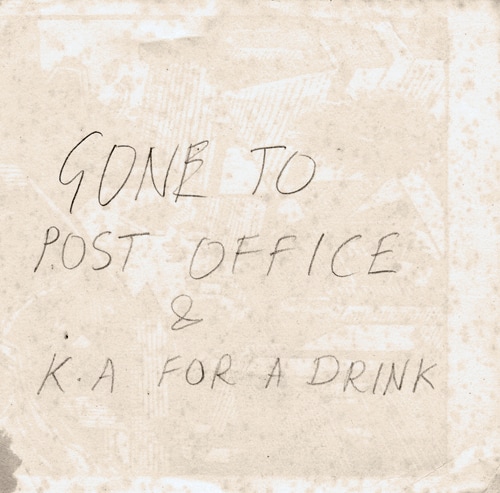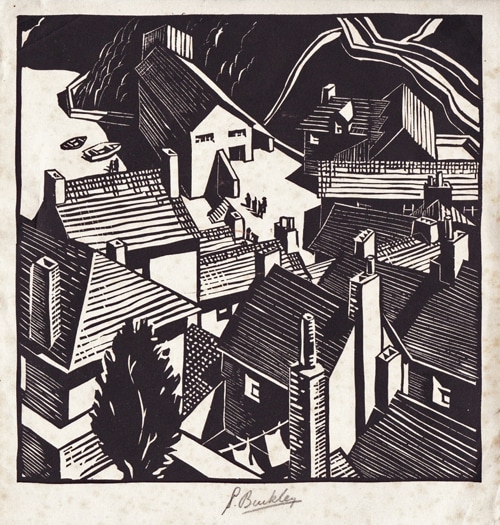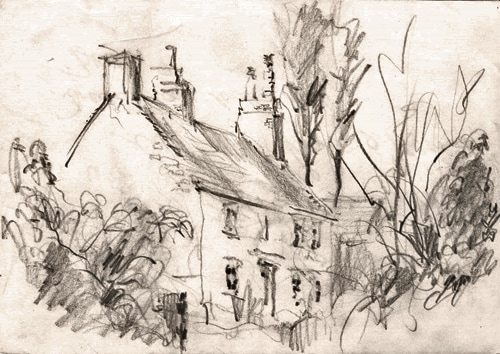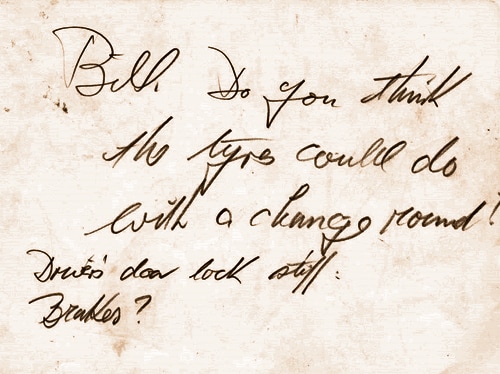|
Today, we are blessed (or not) with a variety of convenient ways to communicate with each other. We can text, tweet and message and if the matter is urgent we can always fall back on ancient technology and make a phone call. In short, we can make contact and are contactable in return wherever we are at any time, instantly. It hasn’t always been this way. Back in the olden days (the 1960s or 1970s, say) if you wanted to communicate your whereabouts to the person you shared a house with, for example, the most expedient way would have been to leave them a note (look it up, kids). Here is just such a note and at first glance it appears to be nothing more than a mundane piece of domestic detritus. The author, as we can see, is off to the post office and the K.A. for a drink. We don’t need to bother Bletchley Park to conclude that in this instance, K.A. stands for Kings Arms. The note isn’t signed but I know who wrote it. I know because this is on the other side: The author was an artist called Sydney Buckley and the note was left for his sister with whom he shared a house at Cartmel in Cumbria. News of Buckley’s whereabouts was written on the reverse of this fine woodblock print titled Cornish Pattern which was designed and printed by Buckley perhaps in the 1940s or 1950s. The scene, typical of Cornwall, is of the rambling rooftops of a town edging on to a beach. In flavour and form it has the feel of Port Isaac, perhaps. It is showing some minor evidence of foxing and this may have existed when Buckley penned the note to his sister. Even so, it is a curious item to use to leave a note. Was there no other paper in the house? Buckley was a noted artist and printmaker (you can see two examples of his etched work on our website here and here) so it seems unlikely that the household was devoid of unused paper. This piece came from a larger collection of prints I bought about ten years ago, all by Buckley. There were ten or so copies of Cornish Pattern and I kept two. One is in mint condition with signature and title and the other is the copy illustrated above. Retained purely for its curiosity value, I was recently reminded of Buckley’s note when I acquired another small collection of artworks. These are all drawings and all by the same unknown hand (one of the many lost artists for whom the term ‘20th Century British School’ was invented). Here is one of the drawings: As we can see, it’s a competent, rapidly executed pencil sketch of a house. It is not fundamentally exciting as an image unless you happen to live in the depicted house, I suppose. Even so, the artist, for whatever reason, took the time and trouble to record the scene. The artist also used the reverse of the sheet for this: As the handwriting isn’t as clear as Buckley’s, here’s a transcript:
'Bill, do you think the tyres could do with a change round? Driver’s door lock stiff. Brakes?' Another note on the reverse of another artwork. It is possible with this example that the note preceded the drawing – at this remove there is no way of knowing for sure. But if the drawing came first, again, one has to ask why? Perhaps the artist dropped the car off at the garage and left the note on the car seat intending for Bill to read the message and then keep the note. This certainly didn’t happen – perhaps Bill didn’t turn the note over to see what was on the other side. Who knows? So many questions raised from two simple relics, each no more than forty of fifty years old, from a time before the age of instant communication. What, I wonder, did Buckley have to drink at the Kings Arms? And the enigmatic ‘Brakes?’ in the second message. Check the brakes? Fix the brakes? Sabotage the brakes? We’ll never know. Comments are closed.
|





 RSS Feed
RSS Feed